ACTCAT, a novel cis-acting element for proline- and hypoosmolarity-responsive expression of the ProDH gene encoding proline dehydrogenase in Arabidopsis
- PMID: 12376638
- PMCID: PMC166600
- DOI: 10.1104/pp.009993
ACTCAT, a novel cis-acting element for proline- and hypoosmolarity-responsive expression of the ProDH gene encoding proline dehydrogenase in Arabidopsis
Abstract
Proline (Pro) is one of the most widely distributed osmolytes in water-stressed plants. We previously isolated from Arabidopsis a gene encoding Pro dehydrogenase (ProDH), a mitochondrial enzyme involved in the first step of the conversion of Pro to glutamic acid. The ProDH gene in Arabidopsis is up-regulated by rehydration after dehydration but is down-regulated by dehydration. ProDH is also induced by L-Pro and hypoosmolarity. The induction of ProDH expression under rehydration seems to be caused by both accumulated Pro and hypoosmolarity. We analyzed a DNA region that is located 5' to the transcription start site (a promoter region) of ProDH to identify cis-acting elements involved in L-Pro-induced and hypoosmolarity-induced expression in transgenic tobacco (Nicotiana tabacum) and Arabidopsis plants. We found that a 9-bp sequence, ACTCATCCT, in the ProDH promoter is necessary for the efficient expression of ProDH in response to L-Pro and hypoosmolarity. Moreover, ACTCAT is a core cis-acting element, which we have called Pro- or hypoosmolarity-responsive element (PRE), that is necessary for L-Pro-responsive and hypoosmolarity-responsive expression of ProDH. Microarray and RNA gel-blot analyses showed that 21 L-Pro-inducible genes have the PRE sequences in their promoter regions. These results indicate that the PRE sequence play an important role in the L-Pro-responsive gene expression.
Figures

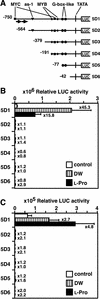

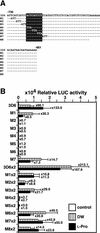
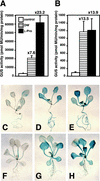
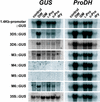
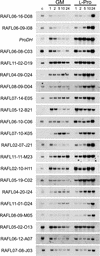

Similar articles
-
A gene encoding proline dehydrogenase is not only induced by proline and hypoosmolarity, but is also developmentally regulated in the reproductive organs of Arabidopsis.Plant Physiol. 1998 Dec;118(4):1233-41. doi: 10.1104/pp.118.4.1233. Plant Physiol. 1998. PMID: 9847097 Free PMC article.
-
A novel subgroup of bZIP proteins functions as transcriptional activators in hypoosmolarity-responsive expression of the ProDH gene in Arabidopsis.Plant Cell Physiol. 2004 Mar;45(3):309-17. doi: 10.1093/pcp/pch036. Plant Cell Physiol. 2004. PMID: 15047879
-
A nuclear gene encoding mitochondrial proline dehydrogenase, an enzyme involved in proline metabolism, is upregulated by proline but downregulated by dehydration in Arabidopsis.Plant Cell. 1996 Aug;8(8):1323-35. doi: 10.1105/tpc.8.8.1323. Plant Cell. 1996. PMID: 8776899 Free PMC article.
-
Regulation of levels of proline as an osmolyte in plants under water stress.Plant Cell Physiol. 1997 Oct;38(10):1095-102. doi: 10.1093/oxfordjournals.pcp.a029093. Plant Cell Physiol. 1997. PMID: 9399433 Review.
-
Proline dehydrogenase in cancer: apoptosis, autophagy, nutrient dependency and cancer therapy.Amino Acids. 2021 Dec;53(12):1891-1902. doi: 10.1007/s00726-021-03032-5. Epub 2021 Jul 20. Amino Acids. 2021. PMID: 34283310 Review.
Cited by
-
Unveiling the protective role of anthocyanin in rice: insights into drought-induced oxidative stress and metabolic regulation.Front Plant Sci. 2024 May 28;15:1397817. doi: 10.3389/fpls.2024.1397817. eCollection 2024. Front Plant Sci. 2024. PMID: 38863532 Free PMC article.
-
Anthocyanins are Key Regulators of Drought Stress Tolerance in Tobacco.Biology (Basel). 2021 Feb 10;10(2):139. doi: 10.3390/biology10020139. Biology (Basel). 2021. PMID: 33578910 Free PMC article.
-
Overexpression of carnation S-adenosylmethionine decarboxylase gene generates a broad-spectrum tolerance to abiotic stresses in transgenic tobacco plants.Plant Cell Rep. 2006 Oct;25(10):1111-21. doi: 10.1007/s00299-006-0160-3. Epub 2006 Apr 27. Plant Cell Rep. 2006. PMID: 16642382
-
Hypoosmotic expression of Dunaliella bardawil ζ-carotene desaturase is attributed to a hypoosmolarity-responsive element different from other key carotenogenic genes.Plant Physiol. 2014 May;165(1):359-72. doi: 10.1104/pp.114.235390. Epub 2014 Mar 14. Plant Physiol. 2014. PMID: 24632600 Free PMC article.
-
Meeting at the DNA: Specifying Cytokinin Responses through Transcription Factor Complex Formation.Plants (Basel). 2021 Jul 16;10(7):1458. doi: 10.3390/plants10071458. Plants (Basel). 2021. PMID: 34371661 Free PMC article. Review.
References
-
- Delauney AJ, Hu C-AA, Kishor PBK, Verma DPS. Cloning of ornithine-δ-aminotransferase cDNA from Vigna aconitifolia by trans-complementation in Escherichia coli and regulation of proline biosynthesis. J Biol Chem. 1993;268:18673–18678. - PubMed
Publication types
MeSH terms
Substances
LinkOut - more resources
Full Text Sources
Molecular Biology Databases

